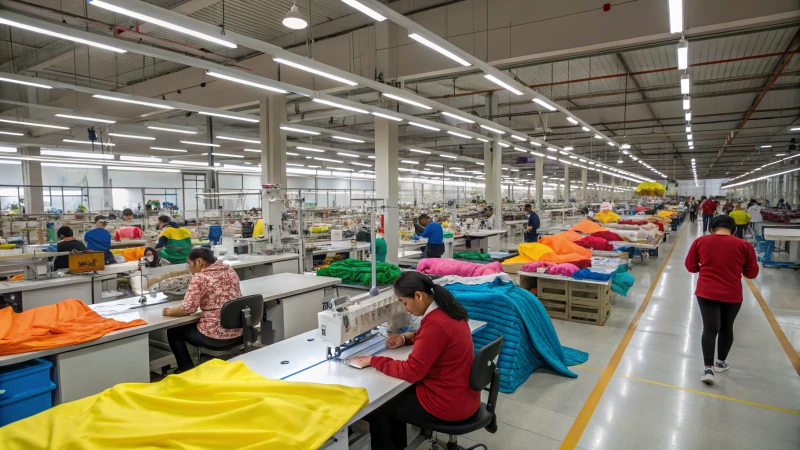
Do you ever think about how your favorite underwear brand stays ahead in a busy market?
Transparent supply chains in the underwear industry allow consumers to understand the details of sourcing and ethical practices. This transparency builds trust and loyalty. Openness encourages fair labor. It really supports sustainability and compliance. Brands stand out in a busy marketplace.
I recall the first time I understood the importance of transparency. It was during a chat with a friend from a small fashion brand. She shared how their focus on ethical sourcing and clear practices really increased consumer trust. Trust probably helped them stand out among the big companies. These practices are more than just trendy terms. They form the backbone of lasting success in the underwear business. Consumers now think more about what they buy. Knowing the story behind a product matters a lot. It truly makes a big difference.
Transparent supply chains boost brand loyalty.True
Transparency builds consumer trust, leading to increased brand loyalty.
Supply chain transparency decreases compliance costs.False
While transparency aids compliance, it may increase short-term costs.
How Does Supply Chain Transparency Enhance Consumer Trust?
Think about the last time you purchased something and felt truly happy about it. That is the real power of a clear and open supply chain.
Supply chain transparency really builds consumer trust. It provides information about sourcing, manufacturing and ethical practices. This helps consumers feel confident about product quality. It also reassures them about ethics.

Building Trust Through Transparency
I remember the first time I looked into where my favorite brand got its materials. It felt like stepping into a hidden world. What I found was amazing - they openly shared their processes, and this made me feel good about my purchases. Transparency in the supply chain means openly sharing information about sourcing, production processes, and worker conditions. This openness not only satisfies my curiosity but also helps me make choices that fit my values perfectly.
Ethical Sourcing and Fair Labor Practices
Sometimes I hesitated to buy from certain brands. I wasn't sure if they treated their workers well or sourced materials ethically. When I found brands that were clear about these practices, I felt relief and trust. Brands that share where their materials come from and treat workers fairly not only follow rules but also connect with people like me who care about ethics. Brands that focus on ethical standards1 often gain loyal customers.
| Aspect | Benefit |
|---|---|
| Ethical Sourcing | Ensures materials are responsibly obtained |
| Fair Labor Practices | Promotes worker rights and safety |
Sustainability and Environmental Impact
I really dislike waste. When brands are open about their sustainability efforts, it truly matters to me. Brands that share clear details about their environmental impact, like recycling projects and use of eco-friendly materials, often gain my loyalty. Knowing I support companies that care for the planet feels great.
The Role of Technology
Technology has probably made it easier for people like me to follow the journey of products from start to finish. With tools like blockchain, brands verify claims about sustainability and ethical sourcing. This helps keep data accurate and builds trust with consumers. Blockchain technology2 really helps keep accurate records and supports transparency in the supply chain.
Case Studies in Transparency
Companies like Patagonia and Everlane are famous among people who value transparency. By sharing information openly, they have built communities of informed consumers. These consumers trust and often stay loyal to these brands. When I shop with these companies, I feel part of something bigger - a move toward ethical consumption.
In summary, while transparency doesn't promise success, it creates a strong base for trust between brands and consumers. By focusing on transparency, companies may address consumer worries, meet ethical duties, and improve their brand reputation.
Supply chain transparency boosts consumer trust.True
Transparency reassures consumers about ethical practices and product quality.
Blockchain technology hinders supply chain transparency.False
Blockchain enhances transparency by ensuring accurate data records.
How Does Ethical Sourcing Impact Brand Reputation?
Have you ever thought about why some brands stand out more to people? Ethical sourcing plays a big role in this. It has a strong influence on how people view the brand. Let's explore how it truly changes things.
Ethical sourcing greatly helps a brand's reputation. It builds trust and loyalty with customers who appreciate honesty and responsibility. Companies stand out in crowded markets. They avoid problems with the law connected to bad practices. Ethical sourcing matters. This approach can really set a brand apart from others.

Building Consumer Trust Through Transparency
I remember the first time I understood why product origins matter. It happened at a fair trade market. A local brand shared passionately about fair wages and safe conditions for all workers in their supply chain. I realized then - knowing product stories connects me more with the brand. Ethical sourcing promises fairness and sustainability. Transparency about where products come from helps brands like that fair trade company really build lasting trust.
Ethical sourcing is more than just a buzzword; it reflects a brand's commitment to fairness and sustainability. By ensuring that products are sourced responsibly, brands can provide consumers3 with the assurance they seek regarding the origins of their purchases. This transparency not only builds trust but also fosters loyalty among ethically conscious buyers.
| Consumer Expectation | Brand Action |
|---|---|
| Fair Labor Practices | Ensure fair wages and safe working conditions for all workers |
| Environmental Impact | Use sustainable materials and eco-friendly production methods |
| Supply Chain Visibility | Offer clear insights into sourcing and production processes |
Differentiating Brands in Competitive Markets
The marketplace feels crowded. My own brand launched, and ethical sourcing set us apart. It was our unique selling point. Our customer base grew because they knew we aligned with their eco-conscious and sustainable values. This stand-out factor helped us rise in market share4. Customers stayed loyal and became brand advocates.
In crowded marketplaces, ethical sourcing can serve as a unique selling proposition that sets a brand apart. Companies adopting ethical practices often find themselves in a favorable position when marketing to eco-conscious audiences.
Mitigating Legal and Regulatory Risks
Staying ahead of legal troubles is very important today. Other brands suffered reputational damage from unethical practices. We chose ethical sourcing for our supply chain and stayed compliant with global standards. This choice reduced risks of fines or bad publicity.
Brands that prioritize ethical sourcing also shield themselves from potential legal troubles linked to unethical practices. This proactive approach ensures compliance with global standards and regulations, minimizing the risk of fines or reputational damage.
Supporting Sustainability Initiatives
I believe businesses really have the power to do good for sustainability. Our ethical sourcing means responsible material choices and eco-friendly production. We even work with groups focused on environmental conservation, which helps our reputation and supports global sustainability efforts too.
Ethical sourcing aligns with sustainability efforts, reducing environmental impact through responsible material selection and production techniques.
Brands committed to sustainable practices often engage in recycling initiatives and collaborate with organizations focused on environmental conservation5.
This commitment not only bolsters brand reputation but also contributes positively to global sustainability goals.
By highlighting these initiatives, brands can attract environmentally conscious consumers eager to make a difference with their purchasing power.
The Role of Consumer Advocacy
Today’s consumers act more than as buyers; they are change-makers. I've seen them support brands practicing ethical sourcing, creating demand across industries.
More companies start adopting these practices.
This shift benefits businesses and pushes a broader societal move towards sustainability.
Today's consumers are not just passive participants; they are active advocates for change.By supporting brands that practice ethical sourcing, they drive demand for more responsible business practices.This consumer-driven shift encourages more companies to adopt ethical sourcing, creating a ripple effect across industries.
Ethical sourcing builds consumer trust.True
Ethical sourcing ensures transparency, fostering consumer trust and loyalty.
Brands with ethical sourcing face more legal risks.False
Ethical sourcing minimizes legal risks by ensuring compliance with standards.
How Does Sustainability Factor into Transparent Supply Chains?
Picture following the path of your favorite product from where it starts to when you hold it. This is the wonder of a supply chain that is both clear and environmentally friendly.
Sustainability helps supply chains become clear by adding eco-friendly practices, ethical sourcing and using resources efficiently. This method builds consumer trust. It also raises the brand's reputation. It follows international standards too.

Eco-Friendly Practices in Supply Chains
Incorporating eco-friendly practices within supply chains begins with sourcing materials responsibly. This involves selecting sustainable resources6 that minimize environmental impact and promote biodiversity. Businesses must also focus on reducing waste and emissions during production.
Another critical aspect is ensuring energy-efficient operations throughout the supply chain. Companies are increasingly adopting renewable energy sources to power their facilities, thus reducing their carbon footprint.
| Key Eco-Friendly Practices | Benefits |
|---|---|
| Sustainable Material Sourcing | Promotes biodiversity and reduces environmental harm |
| Waste Reduction | Minimizes landfill contributions and enhances recycling efforts |
| Renewable Energy Usage | Decreases reliance on fossil fuels and cuts emissions |
Ethical Sourcing and Labor Practices
Transparent supply chains must adhere to ethical labor practices, ensuring fair wages and safe working conditions. Visiting a supplier showed the impact of fair wages and safe conditions on lives. Ethical labor practices were not just about following rules; they built communities where everyone felt important and respected.
Establishing partnerships with suppliers who share similar values is crucial. Brands must regularly audit their supply chains to verify compliance with ethical standards.
Enhancing Consumer Trust through Transparency
Transparency in supply chains involves openly sharing information about sourcing, production methods, and labor practices with consumers. Sharing the story of our products was like opening a door to our world. Transparency invited our customers to join our path toward sustainability.
- Certification: Utilizing certifications like Fair Trade or Organic can bolster a brand's credibility.
- Traceability: Implementing technologies such as blockchain enables detailed tracking of products from origin to end-user.
Regulatory Compliance and Global Standards
Aligning with global sustainability standards helps businesses mitigate legal risks and ensures adherence to environmental regulations. Understanding global sustainability standards felt like learning a new language about caring for our planet. Staying informed about changing policies became a strategic benefit.
Brands must keep abreast of evolving policies that govern sustainability in supply chains to maintain compliance and capitalize on emerging opportunities.
Adopting these sustainable practices within transparent supply chains not only fulfills consumer expectations but also positions brands as leaders in ethical business operations. Exploring case studies7 of companies excelling in this domain can provide valuable insights into successful implementation strategies.
Sustainable material sourcing promotes biodiversity.True
Sourcing materials sustainably reduces environmental harm and supports biodiversity.
Transparent supply chains ignore ethical labor practices.False
Transparency involves adhering to ethical labor standards, ensuring fair wages.
What are the challenges and solutions for implementing transparency?
Have you ever tried to uncover business secrets but found barriers instead? Transparency seems ideal. The path to it is really confusing.
Navigating the transparency maze is tricky. People face hurdles like data privacy, resistance to change and allocating resources. Solutions include clear communication and using tech tools. Regulatory compliance also helps. Involving stakeholders probably pushes these efforts forward. Stakeholders play a crucial role.

Navigating Data Privacy Concerns
Imagine this scenario: you are ready to expand your business activities, but you suddenly face the challenge of data privacy. Finding the balance between being clear and protecting sensitive data feels difficult. I have experienced this myself. The answer? Adopt strong data protection measures8 that follow GDPR and other rules. This step is crucial.
| Challenge | Solution |
|---|---|
| Data Privacy | Implement robust data protection |
| Resistance to Change | Foster a culture of open communication |
Overcoming Resistance to Change
Change feels frightening - I understand. When I first encouraged more openness in my ventures, some employees worried about constant monitoring or more work. Developing a culture of open communication9 was essential. Receiving feedback and providing training programs helped everyone align with our transparency goals. Training helped a lot.
Resource Allocation Challenges
Transparency comes at a cost, especially for small businesses like mine. Resources could quickly run out without smart strategies. A significant help came from using technology like blockchain. Blockchain technology10 offers a permanent record-keeping system. It increases transparency effectively and saves money.
Regulatory Compliance
Complex legal terms and compliance used to bore me. Yet, businesses should follow frameworks like GDPR. Though it seems overwhelming, hiring legal experts simplifies the process. They help keep transparency efforts compliant.
Collaborating with Stakeholders
From my experience, working with external partners like suppliers and customers greatly improved our transparency efforts. Collaborative projects lead to mutual benefits, improving brand reputation and customer trust. Shared sustainability projects, for instance, highlight eco-friendly initiatives11. These connect well with today’s environmentally aware consumers.
These strategies offer practical solutions for businesses seeking to integrate transparency into their operations while addressing common problems.
GDPR mandates transparency in data usage.True
GDPR requires businesses to be transparent about how they use personal data.
Blockchain increases resource needs for transparency.False
Blockchain offers cost-effective, immutable record-keeping, reducing resource strain.
Conclusion
Transparent supply chains in the underwear industry enhance consumer trust, promote ethical sourcing, and support sustainability, ultimately leading to brand loyalty and competitive advantage.
Exploring the benefits of ethical sourcing helps understand its impact on consumer trust and brand reputation. ↩
Discovering how blockchain technology enhances transparency can provide insights into modernizing supply chains. ↩
Learn how transparency influences consumer trust and impacts buying decisions. ↩
Discover how ethical practices can differentiate brands in competitive markets. ↩
Explore how brands contribute to sustainability through responsible sourcing. ↩
Understand the significance of choosing sustainable resources to minimize environmental impact in supply chains. ↩
Explore real-world examples of companies that have successfully integrated sustainability into their supply chains. ↩
This link will guide you through the best practices in data protection, crucial for balancing transparency and privacy. ↩
Discover effective methods to cultivate a workplace culture that supports transparency through open communication. ↩
Explore how blockchain technology serves as a reliable tool for achieving transparent operations in businesses. ↩
Learn from successful case studies of sustainability projects that promote transparency and stakeholder collaboration. ↩






